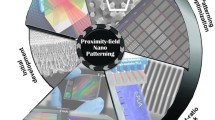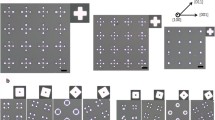Abstract
The development of strategies for shape-programming polymer materials has been considerably growing. This is due to the possibility of shifting two to three-dimensional shapes producing nanotexturing, such as nanowrinkles. In this work, nanowrinkle patterns were produced in polypropylene (PP) films using a broadband non-monochromatic radiation ranging from 3 to 21 eV by a synchrotron source. The superficial modification was investigated by scanning electron microscopy (SEM) and atomic force microscopy (AFM). Additionally, X-ray photoelectron (XPS) and Raman spectroscopy were used to study the chemical modifications of the PP samples. The surface modifications became more evident as the exposure time increased, proving that the formation of nanowrinkles presents a time-dependent behavior, clearly proved by AFM and SEM analysis. Another important aspect is that nanowrinkles consist of a thin layer compatible with the photon penetration depth in this energy range with almost no change in bulk. The spectroscopic results show crosslinking and unsaturated bonds formation increase as a function of time, which corroborates nanowrinkle formation via stress creation on the surface plane, and the relief of this stress outside the plane.
Graphical abstract









Similar content being viewed by others
References
Rodríguez-Hernández J (2015) Wrinkled interfaces: taking advantage of surface instabilities to pattern polymer surfaces. Prog Polym Sci 42:1–41. https://doi.org/10.1016/j.progpolymsci.2014.07.008
Zhao ZJ, Li X, Park SH (2015) Generation of various wrinkle shapes on single surface by controlling thickness of weakly polymerized layer. Mater Lett 155:125–129. https://doi.org/10.1016/j.matlet.2015.04.093
Ahad UI, Andrzej B, Henryk F, Jerzy K, Barbara K, Tomasz C, Dermot B (2014) Surface modification of polymers for biocompatibility via exposure to extreme ultraviolet radiation. J Biomed Mater Res 102:3298–3310. https://doi.org/10.1002/jbm.a.34958
Liu Y, Genzer J, Dickey MD (2016) 2D or not 2D: shape-programming polymer sheets. Prog Polym Sci 52:79–106. https://doi.org/10.1016/j.progpolymsci.2015.09.001
Skurat V (2003) Vacuum ultraviolet photochemistry of polymers. Nucl Instrum Methods Phys Res B 208:27–34. https://doi.org/10.1016/S0168-583X(03)00636-0
Hatano Y (1999) Interaction of photons with molecules—cross-sections for photoabsorption, photoionization, and photodissociation. Radiat Environ Biophys 38:239–247. https://doi.org/10.1007/s004110050164
Nenner I, Beswick JA (1987) Molecular photodissociation and photoionization. In: Marr GV (ed) Handbook on Synchrotron Radiation. Elsevier, Amsterdam, pp 355–466. https://doi.org/10.1016/C2009-0-09951-6
Li Y, Hayashi A, Saito M, Vacha M, Murase S, Sato H (2006) Degradation of aliphatic polyesters by vacuum ultraviolet irradiation. Polym J 38:395–399. https://doi.org/10.1295/polymj.38.395
Kim YJ, Taniguchi Y, Murase K, Taguchi Y, Sugimura H (2009) Vacuum ultraviolet-induced surface modification of cyclo-olefin polymer substrates for photochemical activation bonding. Appl Surf Sci 255:3648–3654. https://doi.org/10.1016/j.apsusc.2008.10.009
Ono M, Yamane H, Fukagawa H, Kera S, Yoshimura D, Okudaira KK, Morikawa E, Seki K, Ueno N (2005) UPS study of VUV-photodegradation of polytetrafluoroethylene (PTFE) ultrathin film by using synchrotron radiation. Nucl Instrum Methods Phys Res B 236:377–382. https://doi.org/10.1016/j.nimb.2005.03.280
Ono M, Morikawa E (2004) Ultraviolet photoelectron spectroscopy study of synchrotron radiation-degraded polyethylene ultrathin films. J Phys Chem B 108:1894–1897. https://doi.org/10.1021/jp030509r
Zhou P, Kizilkaya O, Morikawa E (2008) Electronic structure of photo-degraded polypropylene ultrathin films. Chem Phys Lett 465:241–244. https://doi.org/10.1016/j.cplett.2008.10.006
Ahad UI, Budner B, Korczyc B, Fiedorowicz H, Bartnik A, Kostecki J, Burdynska S, Brabazon D (2014) Polycarbonate polymer surface modification by extreme ultraviolet (EUV) radiation. Acta Phys Pol A 125:94–98. https://doi.org/10.12693/APhysPolA.125.924
Brazilian Synchrotron Light Laboratory. URL https://www.lnls.cnpem.br/
Cavasso Filho RL, Homem MGP, Landers R, Naves de Brito A (2005) Advances on the Brazilian toroidal grating monochromator (TGM) beamline. J Electron Spectrosc Relat Phenom 144:1125–1127. https://doi.org/10.1016/j.elspec.2005.01.253
Cavasso Filho RL, Homem MGP, Fonseca PT, Naves de Brito A (2007) A synchrotron beamline for delivering high purity vacuum ultraviolet photons. Rev Sci Instrum 78:115104. https://doi.org/10.1063/1.2813341
Brazilian Nanotechnology National Laboratory. URL http://lnnano.cnpem.br/
Annual book of ASTD standards (2009) D3359-07 Standard test methods for measuring adhesion by tape test, ASTD International, West Conshohocken, PA. https://doi.org/10.1520/D3359-17.
Burmeister F, Coutinho L, Marinho R, Homem MGP, de Morais M, Mocellin A, Björneholm O, Sorensen S, Fonseca P, Lindgren A, de Brito AN (2010) Description and performance of an electron-ion coincidence TOF spectrometer used at the Brazilian synchrotron facility LNLS. J Electron Spectrosc Relat Phenom 180:6–13. https://doi.org/10.1016/j.elspec.2010.02.007
Au JW, Cooper G, Brion CE (1993) The molecular and dissociative photoionization of ethane, propane, and n-butane: absolute oscillator strengths (10–80 eV) and breakdown pathways. Chem Phys 173:241–265. https://doi.org/10.1016/0301-0104(93)80143-W
Koizumi H, Yoshimi T, Shinsaka K, Ukai M, Morita M, Hatano Y, Yagishita A, Ito K (1985) VUV-optical oscillator strength distributions of C3H6 and C4H8 isomers. J Chem Phys 82:4856–4861. https://doi.org/10.1063/1.448655
Lide D (2004) CRC Handbook of Chemistry and Physics, 85th Edition, no. v. 85 in CRC Handbook of Chemistry and Physics, 85th Ed, Taylor & Francis. URL https://books.google.com.br/books?id=WDll8hA006AC.
Araujo JR, Silva AM, Gouvea CP, Lopes ES, Santos RAA, Terrazos LA, Capaz RB, Achete CA, Maciel IO (2016) Phosphorous bonding in single wall carbon nanotubes studied by X-ray photoelectron spectroscopy and DFT calculations. Carbon 99:1–7. https://doi.org/10.1016/j.carbon.2015.11.059
Chodak I (1999) Crosslinking of polypropylene. In: Karger-Kocsis J (ed) Polypropylene. Polymer Science and Technology Series, vol 2. Springer, Dordrecht, pp 128–134
Lee WK, Engel CJ, Huntington MD, Hu J, Odom TW (2015) Controlled three-dimensional hierarchical structuring by memory-based sequential wrinkling. Nano Lett 15:5624–5629. https://doi.org/10.1021/acs.nanolett.5b02394
Huntington MD, Engel CJ, Hryn AJ, Odom TW (2013) Polymer nanowrinkles with continuously tunable wavelengths. ACS Appl Mater Interfaces 5:6438–6442. https://doi.org/10.1021/am402166d
Basu SK, Scriven L, Francis L, McCormick A (2005) Mechanism of wrinkle formation in curing coatings. Prog Org Coat 53:1–16. https://doi.org/10.1016/j.porgcoat.2004.08.007
Acknowledgements
The authors would like to express their gratitude to the staff of the Brazilian Synchrotron National Facility (LNLS) (proposal TGM 17983, TGM-15928 and TGM-20150235) and Brazilian Nanotechnology National Laboratory (LNNano) (proposal AFM1-18242, AFM-20546, SEM 18226, XPS-18173 and XPS-20307) for their valuable help during the experiments. M.G.P.H., W.R.W and S.A.C acknowledge FAPESP for the financial support under grants 2015/08258-2, 2016/24936-3 and 2016/25703-2, respectively. This research was also supported by the Brazilian agency CAPES (Finance Code 001).
Author information
Authors and Affiliations
Corresponding author
Ethics declarations
Conflict of interest
The authors declare that they have no conflict of interest.
Additional information
Handling Editor: Dale Huber.
Publisher's Note
Springer Nature remains neutral with regard to jurisdictional claims in published maps and institutional affiliations.
Supplementary information
Rights and permissions
About this article
Cite this article
Fitaroni, L.B., Cacuro, T.A., Costa, C.A.R. et al. Polymeric nanowrinkles: surface modification of polypropylene films in the VUV energy range. J Mater Sci 56, 9532–9543 (2021). https://doi.org/10.1007/s10853-021-05879-1
Received:
Accepted:
Published:
Issue Date:
DOI: https://doi.org/10.1007/s10853-021-05879-1




